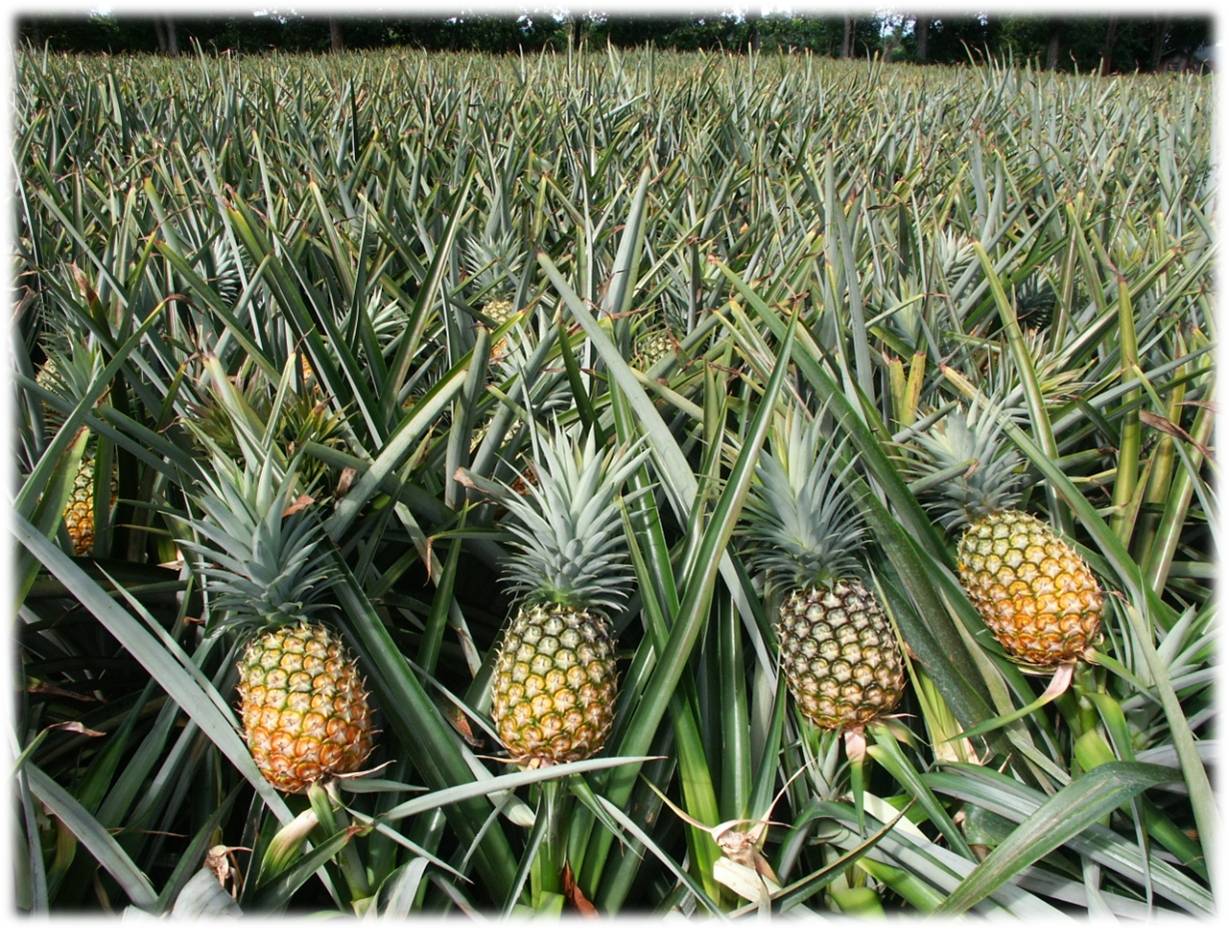
Pineapple is the significant fruit crop of India. It is a popular fruit worldwide due to its pleasant taste. Pineapple is a good source of vitamins A and B and is quite rich in vitamin C and minerals and vitamin C such as calcium, iron, magnesium and potassium. This pineapple is also a source of bromelain, a digestive enzyme. In addition to eating fresh, the fruit can also be canned and processed in various forms. In the world, total production is estimated at 14.6 million tonnes of fruit. India is the fifth-largest pineapple producer, with about 1.2 million tonnes annual production.
Pineapple farming is majorly seen in India in northeast reasons like Maharashtra, Goa, Kerala, West Bengal, Bihar, Goa, and Karnataka. Here we are discussing the what is the process and guidelines of Pineapple farming in India.
Process of Pineapple Farming

When you are initially in the stage of pineapple farming, this blog is vital for you. Pineapple farming is profitable for every farmer. Therefore you should also need to know some factors. When you start the processing of tilling the crop, then you require the tractors and implements. When choosing a tractor, you should be aware because the tractor is the more prior segment for generating a high yield. You can choose Mahindra tractor models because brands produce the best tractor, and apart from this, you can choose among the Eicher, Mahindra, Powertrac brands for every kind of farming. Let’s look at further information regarding pineapple farming.
1. Pineapple Growth – Climate Requirement
For pineapple farming, areas with heavy rainfall are best. The optimum rainfall is 1500 mm per year, although it can increase in areas with 500 mm to 5550 mm of rainfall. Pineapple is suitable for cultivation in moist tropics. The fruit grows well on the beach and in the interior; Unless the temperature is extreme. The fruit grows well near the coastline as well as inland, as long as the temperature ranges from 15.5 – 32.50 °C. Low temperatures, strong sunlight and total shade are harmful. It can successfully grow up to 1525 metres above sea level.
2. Pineapple Crop – Soil Requirement
Farmers grow a pineapple in usually any type of soil. It is convenient for free-draining. For pineapple cultivation, slightly acidic soil with a 5.5 to 6.0 pH range is considerably optimum. You must use soil that is light in texture and well-drained. Heavy clay soil is not preferable in pineapple crops. It can grow in alluvial or laterite and sandy soil.
3. Season of Pineapple Farming
Farmers should plant the pineapples 12-15 months before the flowering season. The flowering season is between the months of December and March. Generally, the planting depends on the onset of the monsoon, its intensity, rainfall etc. It is planted during April-June in Karnataka and Kerala, while in Assam, it is done from August to October.
4. Pineapple Production – Land Preparation
You can prepare the land for planting through digging or ploughing; after that, the levelling begins. Depending on the trenches of convenient length and nature of the land, 15 to 30 cm the depth and 90 cm the width are prepared.
5. Best Season for Pineapple Plantation
Pineapple fruit is a humid tropical plant. It grows well in plains and also at altitudes above 900 m. It neither tolerates very high temperatures nor frost. Generally, pineapples have flowers from February to April, and fruits are ready from July to September. Sometimes, off-season flowers develop, and they bear fruit from September to December.
6. Pineapple Production – Planting Material Requirement
Farmers usually propagate through slip, sucker and crown. This 5-6-month-old planting material flowers 12 months after planting except for the crowns, which flower after 19-20 months. Pineapple plants produced by tissue culture are also available for cultivation.
7. Pineapple Planting
Unlike other crops, you can propagate pineapple through sucker, crown and slip. Therefore, the planting materials used in pineapple cultivation are crown, slip, and sucker. Flowering occurs in the crown 19-20 months after plantation, whereas in slip and sucker, flowers appear 12 months after plantation. Therefore, the planting material used for cultivation should be 5-6 months old. Slips and suckers are used for commercial purposes because the crown takes longer to flower. The material should be of uniform size. Slips and suckers are planted in previously dug and prepared trenches.
8. The Spacing of Pineapple Plants
High-density cultivation is a recommendation for commercial viability. A planting density of 63,400 plants/ha (22.5 x 60 x 75 cm) is ideal for subtropical and mildly humid conditions, while a plant density of 53,300 plants/ha for hot and humid conditions at a plant-to-plant spacing of 25 cm. In rainfed, highly fertile and hilly areas in northeastern states, a somewhat lower density of 31,000 plants/ha is recommended.
9. Pineapple Farming – Intercultural Operations
Earthing up is a crucial operation in pineapple farming that aims at providing good anchorage to the plants. This involves pushing the soil from the ridge into the trench, where trench planting is a common practice. Since pineapple roots are very shallow, the plant eventually lodges under conditions of flat-bed planting, especially in areas with heavy rainfall.
Keeping plants while fruits are developing will result in unilateral growth, unilateral growth and fruit ripening. This action becomes more important in ratoon crops, as the base of the plant changes, crop after crop. High-density planting will reduce the need for this operation, as the plants keep each other from living.
10. Pineapple Farming – Irrigation Requirement
Farmers cultivate pineapple under rain-fed conditions. Supplementary irrigation produces good-sized fruits in areas with optimum rainfall. Irrigation also helps establish an off-season planting to maintain its year-round production. In case of low rainfall and hot weather, irrigation can be done once in 20-25 days.
11. Manures, Nutrient and Fertiliser Management in Pineapple Crop
Pineapple is a shallow feeder with potassium and nitrogen requirements. Since these nutrients are apt to heavy losses in the soil, practises related to the form of fertilizer and timing of application determine their efficient use. Experts recommend giving N and K2O at 12 grams per plant based on research conducted at various places. However, if the soil is poor in P, 4 g of P2O5/plant may be applied.
You should apply the nitrogen in 6 split doses. You should give the 2 months N first dose after planting and the last dose after 2 months. Farmers should give the potash in 2 split doses. They can give the entire P and half dose of K at the time of planting. And the remaining K give after 6 months. You should apply fertiliser when moisture is available.
12. Harvest and Yield of Pineapples
After planting, pineapple plants flower in 12 to 15 months and are fruit ready 15-18 months depending on prevailing temperature and variety during fruit development, time of planting, type and size of plant material. Pineapple comes for harvesting during May-August under natural conditions. The fruits usually ripen about 5 months after flowering—irregular flowering results in long spreading cuttings. To obtain uniform flowering (more than 80%) in the main season, Aetherel (@100ppm) solution is applied to the plants one month before flowering.
Equipment Requirement
Along with the information about pineapple cultivation, you should also know about the tools that will help in increasing the yield. Tractors are an essential segment in every farming. However, the Kubota tractor is the most effective tractor for farming. Apart from this, you can choose from Eicher tractors and many more.
For more information regarding Pineapple farming in India, stay tuned with us.




